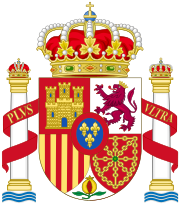 |
|---|
Government in Spain is divided into three spheres or levels: the State itself, the regions or autonomous communities and local entities (municipalities and groups of municipalities).[1][2][3][4][5] These levels are not hierarchical, meaning there is no supremacy or primacy of one over the other, but rather they are separately defined by their jurisdictional powers (Spanish: competencias).[6][7]
The second sphere, that of the regions or autonomous communities, is the second-level subdivision (using the definition of NUTS and OECD) or the first-level subdivision (using the definition of FIPS, CIA World Factbook and ISO 3166-2). There are 17 autonomous communities and two autonomous cities (Melilla and Ceuta) in all these schemes.
The third sphere, that of local entities and local government, comprises three different subdivisions of Spain, with differing political (council), electoral (constituency), or administrative (decentralised services of the state) functions as well as other entities described below. Accordingly Spain is divided territorially into:
- 8,131 municipalities and 3,683 sub-municipal entitles each with political, administrative and are their own constituencies.
- 465 comarcas, 83 of which have administrative and political functions
- 50 provinces, nine of which have no political or administrative function but all of which are constituencies for both houses of Parliament.
In practice most local government power is vested in municipalities; provincial councils are limited to providing support for smaller municipalities.[8][9][10][11][12] Nevertheless (and ignoring the lack of administrative function in nine provinces) taken together, the 50 provinces, 7 islands and two autonomous cities are defined as third-level subdivisions by NUTS and OECD. The 50 provinces by themselves are defined as second-level by FIPS, CIA World Factbook and ISO 3166-2. Comarcas are not featured in any of these schemes.
Although municipalities are required by law to not cross provincial boundaries, comarcas have no such restriction, so there is no perfect division of provinces into comarcas; they are disjoint divisions made up of different municipalities. For example, the comarca of Tierra de Pinares is split between two provinces and the comarca of Cerdanya is divided between France and Spain.
Both provinces and comarcas are groupings of municipalities. There are other groupings of municipalities with administrative functions defined by regional legislation including mancomunidades, metropolitan areas, juntas etc but they are not a territorial or administrative subdivision of Spain as a whole.
Related to provinces, there is another territorial division of Spain into 431 judicial districts which are the constituencies for the election of provincial councils.
In terms of the separation of powers, the national government contains all three branches of government (judiciary, executive and legislative); regional governments only have executive and (unicameral) legislative branches (no judiciary). Local government is administrative only[3] and their regulations must adhere to national and regional law.
In terms of relative size of each tier, in 2002, the central government accounted for 48.7% of public expenditure, regional government for 35.5% and local government for 15.8%.[13]
- ^ MPA 2022, paragraph 1,4.
- ^ Moreno 2016, p. 183.
- ^ a b Synopsis of Article 137 of the Constitution, paragraph 7.
- ^ Albet i Mas 2019, p. 20.
- ^ Division of Powers, paragraph 7.
- ^ Moreno 2016, p. 184.
- ^ MPA, paragraph 1.
- ^ Canel 1994, p. 51.
- ^ Sánchez Morón 2017, paragraph 16.
- ^ Cools & Verbeek 2013, Explanatory Memorandum paragraph 212 on page 37.
- ^ MPA 2022, p. 3.
- ^ Division of Powers, paragraph 10.
- ^ Moreno 2007, p. 87.